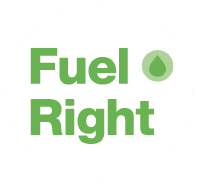Understanding Cold Weather #2 Fuel Issues
Fuel Right Founder Bob Tatnall Discusses The Issues With #2 Heating Oil In Winter & How Fuel Right Products Can Quickly & Safely Solve Them

When temperatures plunge fuel sometimes
doesn't flow. Why this happens and what one can do about it are widely
misunderstood issues and worth discussing.
The first thing that causes cold flow problems - and by far the most
common winter problem with diesel fuel and heating oil - is fuel line freeze-ups
.
This has
nothing to do with the makeup or quality of the fuel itself, but is rather simply
water freezing at or below 32 F. Water collects in low spots in fuel lines and
at the bottom of tanks. Sludge deposits - which are essentially water-filled
masses, likewise usually collect at low spots in the system. When the
temperature drops below the freezing point of water these things can freeze
solid and restrict flow. Fuel pumps are generally better at pushing fuel than
at "sucking" fuel, so they just stop working if the restriction
becomes too great.
The answer to fuel line freeze-ups is to use a fuel anti-freeze.
Alcohols fit this category - but, for reasons discussed in other tech notes,
alcohols are generally not good in #2 fuel systems. A better answer is to treat
with glycol ethers. These are used in aviation fuels for the same purpose - and
are what are sprayed on the wings of airplanes in the winter to prevent ice
buildup. Glycol ethers do not carry any operating downside as do alcohols. What
is more, they will accumulate in aqueous deposits throughout the year and offer
freeze protection even months later is those deposits are still there when winter arrives.
All
Fuel Right products (except for Concentrated Formula, or 30K) contain a healthy
amount of DPM glycol ether - the best form of fuel antifreeze. Incidentally,
blending kerosene with #2 fuel does nothing to prevent fuel line freeze-ups.
The second problem to occur as the
temperature continues to drop is waxing
of filters.
Somewhere below about 20 F paraffin starts to come out of
the fuel, and the fuel starts to appear cloudy. The temperature at which this
happens is reported as the "cloud point" of the fuel. This by itself
means little, but it is easy to measure and is often included in fuel analyses.
At some point below the cloud point, enough wax has precipitated to build up on
the surface of cold filters and, eventually, seal the filter against flow. At
this point the system shuts down until the filter is heated or replaced. The
wax readily melts back into the fuel if it is warmed slightly.
Waxing is only a
problem where the filter and the fuel are cold - usually outdoors. It is
retarded or inhibited by treating the fuel with what are called "wax
crystal modifiers" - or by blending kerosene into the fuel to dilute the
paraffin concentration. Kerosene blending at up to 50% concentration is the
best and surest way to retard waxing - but it carries a list of negatives that,
in the minds of some, more than make up for its cold-flow benefits.
The last problem to occur as the
temperature continues to drop is gelling
of the fuel. This occurs when enough wax comes out of the fuel to make it a
heavy slush that won't move. The lowest temperature at which the fuel is still
a pourable liquid is called the "pour point" of the fuel.

To learn more about the line of Fuel Right products can be used to solve all your winter heating oil issues, visit -
http://FuelRight.com
And if you have any questions on how best to use the Fuel Right products in your specific application, feel free to call us at 302-425-4400
Contact Us
Fuel Right
41 Germay Drive,
Wilmington, DE 19804
Phone: (302) 425-4400
Email: sales@fuelright.com
Web: http://FuelRight.com
Upcoming Events
Upper Midwest
Convenience Store & Expo
